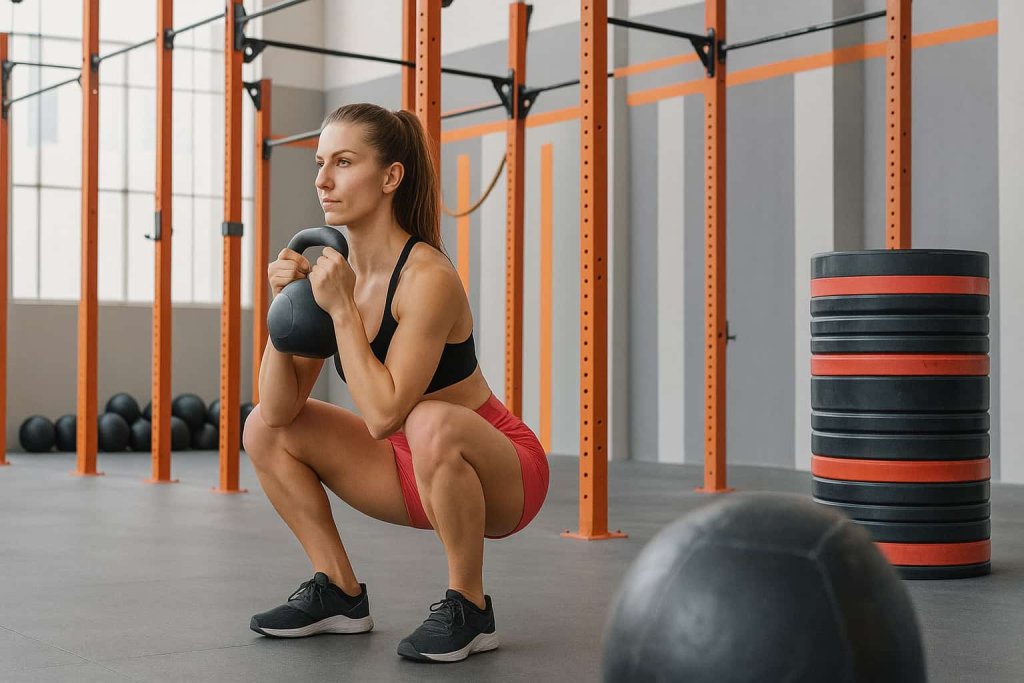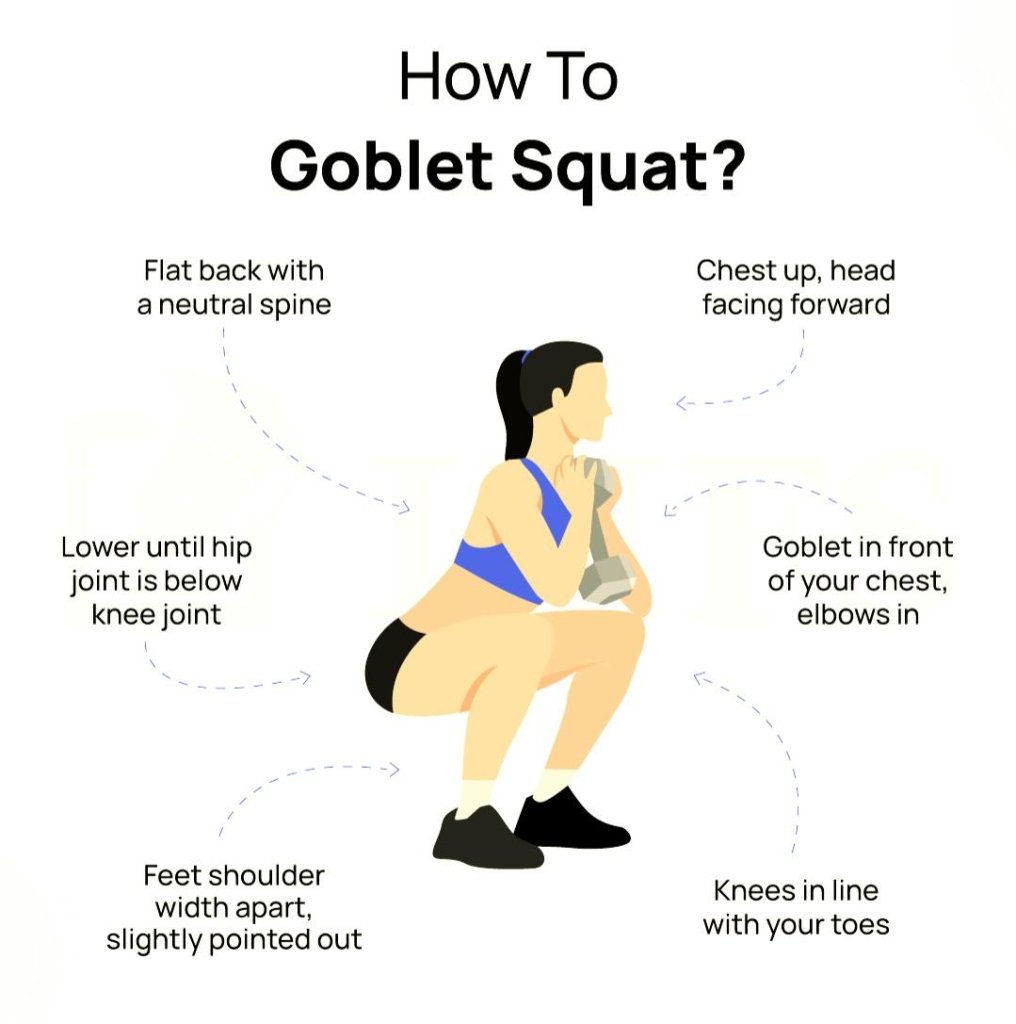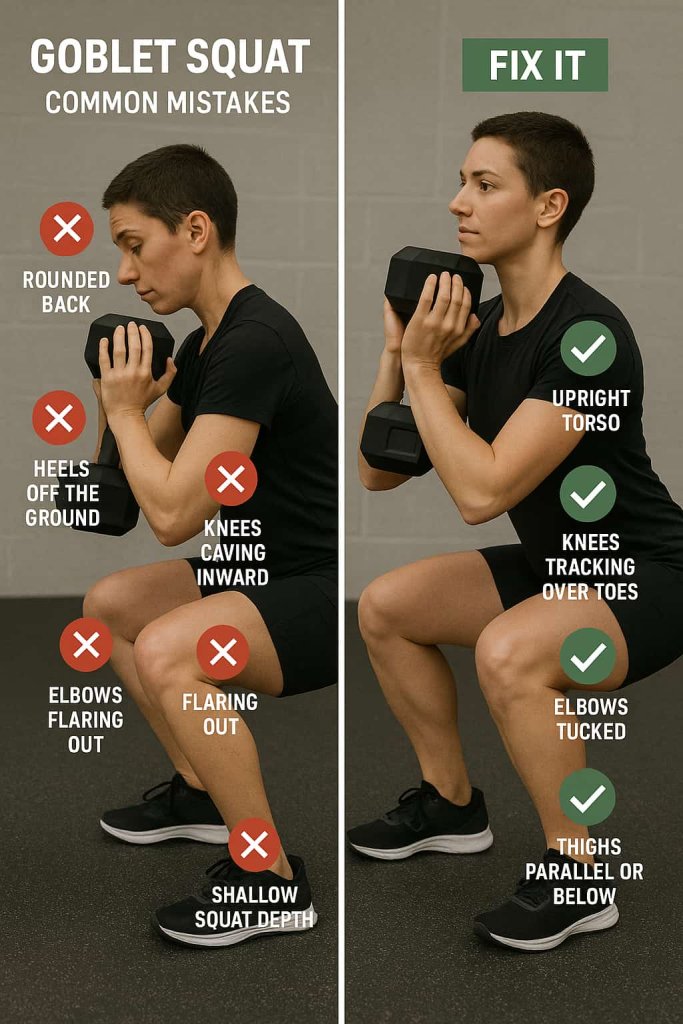The goblet squat is one of the best exercises for building lower body strength, improving squat technique, and increasing overall mobility—all with minimal equipment. By holding a single dumbbell or kettlebell at your chest and squatting down, you engage your quads, glutes, hamstrings, and core muscles, while reducing the strain on your lower back compared to barbell squats.

Understanding how to perform the goblet squat correctly is crucial for beginners and experienced lifters alike. This move is not just a stepping stone to more advanced squats—it’s an essential training tool for everyone who wants to move better, lift heavier, and stay injury-free. In this comprehensive guide, you’ll learn:
- Step-by-step proper form for the goblet squat
- Key benefits and muscles worked (with research-backed facts)
- The most common mistakes and how to avoid them
- Powerful goblet squat variations for any fitness level
- Best alternatives if goblet squats aren’t an option
- Pro trainer tips for faster progress
For official technique and safety, visit the ACE Exercise Library: Goblet Squat.
How to Do the Goblet Squat: Step-by-Step Proper Form

- Set Up Your Stance
Stand with your feet hip- to shoulder-width apart. Most people find comfort with toes pointed slightly outward (10–20°). Grip a dumbbell vertically (one head in each palm) or hold a kettlebell by the horns. Keep the weight close to your chest with your elbows tucked downward. - Brace and Descend
Brace your core as if someone is about to punch your stomach—this protects your lower back. Begin the movement by pushing your hips back slightly, then bend your knees to squat down. Keep your chest upright, eyes forward, and elbows pointing down toward the floor (they should track inside your knees as you squat). Lower yourself until your thighs are at least parallel to the ground or deeper if mobility allows, while maintaining a neutral spine.

3. Stand Up Powerfully
Push your feet through the floor, driving up through your heels and midfoot. Squeeze your glutes at the top of the movement, fully extending your hips. Repeat for 8–15 reps per set, keeping movement smooth and controlled.
Key cues: Keep chest up. Don’t let your elbows flare. Weight stays close to your body. Knees track over toes.
Muscles Worked and Top Benefits of the Goblet Squat
Muscles Targeted
- Primary: Quadriceps, gluteus maximus, hamstrings
- Secondary: Adductors (inner thighs), calves, abdominals, obliques, lower back, upper back, shoulders, and forearms

Why the Goblet Squat Works
- The upright torso position reduces lumbar (lower back) stress compared to traditional barbell squats, making it a safer option for beginners and those with back pain.
- Holding a weight at the chest increases core and upper back activation, training your body for proper posture and stability.
- The goblet squat improves hip, knee, and ankle mobility by encouraging you to squat deeper with better technique.
- It is a great “corrective exercise” for people learning squat mechanics or fixing “butt wink,” forward lean, and knee cave-in issues.
Additional Benefits
- Low risk, high reward: Very hard to do wrong when you follow proper cues—great for beginners.
- Teaches perfect squat depth: The counterbalance makes it easier to reach full depth.
- Translates to daily life: Builds the strength needed for activities like sitting, standing, lifting, and climbing stairs.
- Versatile: You can add tempo, pulses, or use different stances to emphasize various muscles.
According to trainers, goblet squats can help you add up to 30% more squat depth versus barbell squats for first-timers.
Common Mistakes and How to Fix Them

| Mistake | Why It’s a Problem | How to Fix It |
|---|---|---|
| Rounding the lower back (butt wink) | Stresses the spine, risks injury | Brace your core, squat only as deep as you can maintain flat back |
| Chest dropping forward | Reduces leg work, increases back load | Keep chest up, elbows in, eyes forward |
| Heels lifting off the floor | Loss of power, poor stability | Press weight through heels and midfoot, not toes |
| Knees caving inward (valgus collapse) | Higher risk of knee injury | Push knees outward, keep over middle toes |
| Not going low enough | Limits muscle growth, mobility gains | Aim for thighs at least parallel to floor or deeper |
| Letting elbows flare or drift away | Ruins counterbalance, can tip you over | Keep elbows tucked and weight glued to chest |
| Using excessive weight | Poor technique, injury risk | Start light, increase weight only with perfect form |
Pro Tip: Record your set from the side and front. Watch for these errors and make small corrections each workout. Small improvements compound over time!
Goblet Squat Variations for All Levels

Goblet squats are one of the most accessible and effective lower-body exercises. By changing your stance, equipment, or tempo, you can target different muscles, challenge your mobility, and progress no matter your fitness level. Below, discover the best goblet squat variations for beginners, intermediates, and advanced lifters.
1. Standard Goblet Squat
What It Is:
The foundational goblet squat. Hold a dumbbell or kettlebell at your chest, feet shoulder-width apart, and squat down while keeping your chest tall.
Benefits:
- Builds quad, glute, and core strength
- Teaches safe squat mechanics
- Great for all fitness levels
How to Do It:
- Stand with feet shoulder-width apart, toes slightly out.
- Hold the dumbbell/kettlebell vertically at your chest, elbows pointing down.
- Brace your core and squat down, pushing your knees out and hips back.
- Lower until your thighs are parallel to the floor (or as deep as comfortable).
- Drive through your heels to stand up.
Trainer Tip:
Keep your elbows inside your knees at the bottom for a strong upright torso.
2. Heels-Elevated Goblet Squat
What It Is:
Place your heels on small weight plates or a wedge (about 1–2 inches high) and perform the goblet squat.
Benefits:
- Increases quadriceps activation
- Allows for a deeper squat
- Helps people with poor ankle mobility
How to Do It:
- Set two small plates or a wedge behind your feet.
- Stand with heels elevated, toes on the floor.
- Hold the weight at your chest and perform a standard goblet squat.
Trainer Tip:
Don’t let your knees cave in. Use the elevation to “sit down” between your knees and keep your torso upright.
3. Sumo Goblet Squat
What It Is:
Take a wider stance (about 1.5–2 times shoulder-width), turn your toes out more, and perform the squat.
Benefits:
- Emphasizes inner thighs (adductors) and glutes
- Improves hip mobility
- Changes the muscle emphasis from standard squats
How to Do It:
- Stand wide, toes pointed out about 30–45 degrees.
- Hold the weight at your chest.
- Squat down, driving knees out and keeping chest up.
- Lower as deep as comfortable, then rise.
Trainer Tip:
Push your knees out to follow your toes throughout the movement.
4. Goblet Box Squat
What It Is:
Use a box or bench behind you as a target for squat depth.
Benefits:
- Teaches safe depth and control
- Reinforces proper hip hinge
- Great for beginners or those learning squat mechanics
How to Do It:
- Set a box or bench behind you at about knee height.
- Hold the weight at your chest.
- Slowly squat down until your glutes touch the box—do not sit or relax.
- Briefly tap, then drive up to stand.
Trainer Tip:
Control the descent and keep tension—avoid “plopping” onto the box.
5. Goblet Split Squat (Bulgarian Split Squat)
What It Is:
Single-leg squat variation. Place your rear foot on a bench behind you and perform a split squat holding the weight at your chest.
Benefits:
- Boosts single-leg strength and stability
- Corrects muscle imbalances
- Improves balance and athleticism
How to Do It:
- Stand 2–3 feet in front of a bench, facing away.
- Rest the top of one foot on the bench.
- Hold the weight at your chest, lower your back knee toward the floor.
- Push through the front heel to return up.
Trainer Tip:
Keep your front knee in line with your toes and torso upright.
6. Paused or Pulse Goblet Squat
What It Is:
Increase the challenge by holding (pausing) at the bottom of the squat, or performing small “pulses” in the lowest third of the movement.
Benefits:
- Increases time under tension (TUT)
- Builds muscular endurance and control
- Forces better form and bracing
How to Do It (Pause):
- Perform a standard goblet squat.
- Pause at the bottom for 2–3 seconds before rising.
How to Do It (Pulse):
- At the bottom, move up and down a few inches (pulses) for 5–10 reps before standing.
Trainer Tip:
Maintain full-body tension and keep your chest tall during pauses or pulses.
7. Trainer Challenge: 1.5 Rep Goblet Squat
What It Is:
A tough progression to increase workload in each rep.
How to Do It:
- Squat all the way down.
- Rise halfway up, then return back down.
- Stand all the way up—that’s one rep.
Why Try It?
- Creates more fatigue and muscle growth with less weight.
- Perfect for advanced lifters who want a new challenge.
Trainer Tip:
Move slowly and control each portion of the movement for maximum benefit.
How to Use Goblet Squat Variations in Your Training
- Beginners: Start with standard and box goblet squats to learn the basics.
- Intermediate: Add sumo or heels-elevated variations to target different muscles.
- Advanced: Incorporate paused, pulse, split squat, and 1.5 rep challenges for strength and muscle gains.
- Mix variations throughout the week for balanced leg and core development.
Expert Trainer Tips for the Goblet Squat
- Warm Up First: Do dynamic hip, ankle, and thoracic spine mobility drills (e.g., hip circles, ankle rocks, cat-cow) before squatting.
- Use a Mirror: Checking your profile in a mirror helps spot chest or knee movement errors.
- Progress Smart: Add reps, weight, or slow down the tempo as you get stronger. Don’t rush to go heavy—form first!
- Breathe Right: Inhale and brace at the top, exhale as you rise.
- Grip Strong: Squeeze the dumbbell or kettlebell tightly to create more upper body tension and better core engagement.
- Routine Placement: Use the goblet squat as a main lift on lower body days or as part of a warm-up circuit for more advanced squats.
- Sample Workout:
- 3–4 sets of 10–15 reps
- Rest 60–90 seconds
- Pair with mobility moves for maximum results
Alternatives to the Goblet Squat
Looking for options due to lack of equipment, mobility issues, or just to mix it up? Try these proven alternatives:
- Bodyweight Squat: Perfect for beginners or high-rep conditioning.
- Dumbbell Front Squat: Hold a dumbbell in each hand at your shoulders for greater loading.
- Barbell Front Squat: Use a barbell in front rack for more advanced lifters who want to load heavier.
- Spanish Squat: Anchor a resistance band behind your knees, squat back—excellent for targeting the quads and reducing knee pain.
- Leg Press Machine: Safer for those with back limitations; easily adjustable load.
- Landmine Squat: Hold a barbell anchored in a landmine device at your chest, squat as usual.
Choose the variation or alternative that matches your mobility, experience, and available equipment.
Frequently Asked Questions (FAQ)
Is the goblet squat effective for building muscle?
Yes! As long as you use enough resistance and maintain good form, goblet squats can build significant leg and glute muscle, especially for beginners and intermediate lifters.
How heavy should my goblet squat be?
Start with a weight you can lift for 10–15 reps with perfect form. For most, this means 10–25 lbs starting out. Progress by increasing the weight by 5–10 lbs when you can easily complete all reps.
How many times a week should I do goblet squats?
2–3 times per week is ideal for most people, with at least 48 hours rest between sessions.
Is it safe for bad knees or lower back?
Goblet squats are often safer than barbell squats. Keep the weight moderate and depth comfortable. If you feel pain, switch to an alternative or consult a professional.
What’s better, dumbbell or kettlebell goblet squat?
Both work well. Kettlebells may be easier to grip and keep close to the chest, but dumbbells are often more accessible.
Conclusion
The goblet squat is a must-have move for anyone who wants better strength, mobility, and functional fitness. It’s accessible, safe, and powerful—no gym required. Start light, master your form, and add this exercise to your regular lower body workouts for fast, lasting results.
